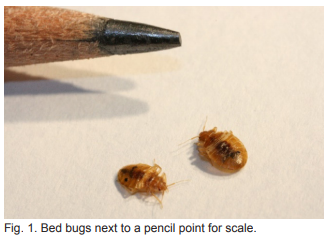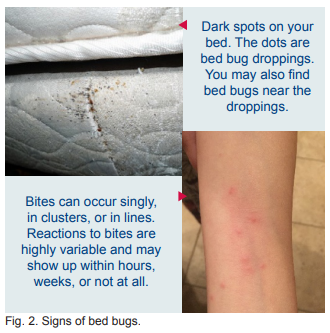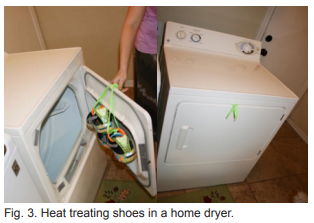Bed Bugs: What Home Care Providers and Welfare Workers need to know
About Bed Bugs
Bed bugs are small, flat, reddish-brown insects (Fig. 1), that feed on the blood of humans. Bed bugs do not transmit disease-causing pathogens. Adult bed bugs are about ¼ inch in length with a flat oval shape and are about the size of an apple seed. They do not jump or fly, but can crawl quickly. Bed bugs generally feed at night and during the day hide in cracks and crevices close to resting areas.
Anyone can acquire bed bugs
Bed bugs are found everywhere people go. They hitchhike on clothing and personal items, and sometimes drop off, as people with bed bug infestations at home go about their daily life. Bed bugs introduced into new places in this way rarely survive, but may be found roving around an area looking for a protective crack or crevice. Person-to-person transfer of bed bugs is unlikely in most instances. However, if your job involves visiting homes, or interacting physically with people, extra precautions should be taken to minimize the risk of accidentally picking up an unwanted hitchhiker.
Where bed bugs are found
Bed bugs are most likely to be found in and near beds, couches, or chairs in which people rest for multiple hours at a time. Clusters of dark spots on mattresses and bedding, and bites on the skin may indicate the presence of bed bugs (Fig. 2).
Preparing to visit a home
▪ Have a spare set of clothes and shoes at the office or in your car. Large plastic bags to cover car seats after a visit are also helpful.
▪ Wear simple, light-colored clothing and shoes, without lots of pockets, cuffs, seams or folds. Choose materials that can be washed and dried in a clothes dryer.
▪ Avoid accessories such as scarves, hats and handbags.
▪ Carry minimal items (preferably only as much as you can easily carry around with one arm) into the residence. If you need to carry paperwork, and equipment use zipper style bags that can be discarded or carrier bags that can be laundered and dried in a clothes dryer.
▪ Carry a flashlight to use when making observations about living conditions.
▪ Use white bed sheets or foldout play mats to kneel on if your job entails interacting with children at floorlevel. Avoid reusing these items in multiple homes without laundering them between visits.
When you arrive at a location
▪ If an infestation has been previously confirmed or is anticipated, consider wearing disposable shoe covers to avoid collecting bed bugs on the undersides of shoes and relocating them to other homes.
▪ If possible avoid sitting on upholstered furniture or beds. Try to sit on a hard surface chair, or carry your own foldable chair.
▪ If you observe bed bugs during your visit, do not panic. Make a note, so you can be prepared next time. Encourage residents to talk openly about pest infestations, bites, and pesticide use.
After you leave the location
▪ Remove disposable shoe covers and place them in a sealable plastic bag for later disposal in an external garbage receptacle.
▪ Inspect yourself thoroughly, looking for any bed bugs or other pests on yourself. Carefully check your clothes, under your shoes, and items taken inside. Use a hand mirror to inspect the back of your pants or under your shoes if shoe covers were not worn.
▪ If you find an insect on yourself, use a tissue or lint roller to pick it up, and place it in a sealable plastic bag. Discard or save it for identification confirmation.
▪ If you have observed bed bugs in a resident’s home, notify your supervisor.
▪ If you suspect you may have bed bugs on yourself after an in-home visit, avoid subsequent home visits before changing clothes and shoes. Return home, or to your office if it is equipped with a shower, washer and dryer.
The provision of laundry facilities, showering and changing rooms in offices where employees regularly visit bed bug infested environments enables employees to launder work clothes at the office and return to their duties with minimal interruption.
Upon returning home (if you do not have laundering and changing facilities at work):
▪ Remove your footwear, bags, and leave them outside the home, or in the garage.
▪ Undress directly into a clothes washer if possible, or into plastic bags in a bathroom area. Double bag clothing until you can launder and dry the items as soon as possible. Avoid bringing worn items into bedrooms or placing items on furniture.
▪ Showering using soap and water is sufficient to remove bed bugs from your person.
▪ Wash your work clothes and dry them completely in a clothes dryer. Once dry, run the clothes on high heat for an additional 30 minutes to make certain that any bed bugs transferred from the washing machine are dead. Heat kills all life stages of bed bugs. Washing alone will not kill them. Dry-cleaning is also effective.
▪ Inspect shoes, bags, and other items carefully before unpacking items in your home. Some shoes can be heated in a clothes dryer by hanging laces over the dryer door and leaving the shoes hung inside (Fig. 3).
▪ Delicate items can be bagged and placed in a freezer for 4 days to kill bed bugs.
▪ Vacuuming personal and work vehicles regularly is advisable, especially if you transport persons or items from infested homes.
If you find bed bugs at home
Try not to panic; bed bugs do not transmit diseasecausing pathogens. The sooner you seek pest control assistance, the easier, faster, and cheaper it will be to eradicate them from your home. Find out your employer’s policy regarding helping employees with bed bugs, some may provide financial help. Find out what your lease agreement is if you are a renter, you may or may not be responsible for the costs. Find an experienced pest management company to exterminate the pest. Bed bugs are challenging insects to control, and require specialized products, equipment, and knowledge to eradicate. FurtherInformation https://extension.arizona.edu/ sites/extension.arizona.edu/files/pubs/az1625-2014. pdf https://extension.arizona.edu/sites/extension. arizona.edu/files/pubs/az1642-2019.pdf


